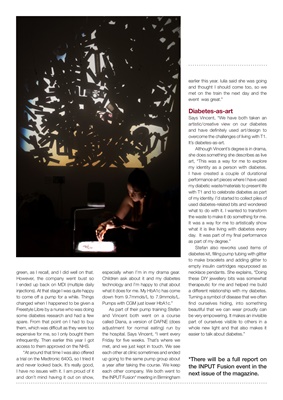
LIVINGLIVING
green, as I recall, and I did well on that.
However, the company went bust so
I ended up back on MDI (multiple daily
injections). At that stage I was quite happy
to come off a pump for a while. Things
changed when I happened to be given a
Freestyle Libre by a nurse who was doing
some diabetes research and had a few
spare. From that point on I had to buy
them, which was difficult as they were too
expensive for me, so I only bought them
infrequently. Then earlier this year I got
access to them approved on the NHS.
"At around that time I was also offered
a trial on the Medtronic 640G, so I tried it
and never looked back. It's really good,
I have no issues with it. I am proud of it
and don't mind having it out on show,
especially when I'm in my drama gear.
Children ask about it and my diabetes
technology and I'm happy to chat about
what it does for me. My HbA1c has come
down from 9.7mmols/L to 7.9mmols/L.
Pumps with CGM just lower HbA1c."
As part of their pump training Stefan
and Vincent both went on a course
called Diana, a version of DAFNE (does
adjustment for normal eating) run by
the hospital. Says Vincent, "I went every
Friday for five weeks. That's where we
met, and we just kept in touch. We see
each other at clinic sometimes and ended
up going to the same pump group about
a year after taking the course. We keep
each other company. We both went to
the INPUT Fusion* meeting in Birmingham
earlier this year. Iulia said she was going
and thought I should come too, so we
met on the train the next day and the
event was great."
Diabetes-as-art
Says Vincent, "We have both taken an
artistic/creative view on our diabetes
and have definitely used art/design to
overcome the challenges of living with T1.
It's diabetes-as-art.
Although Vincent's degree is in drama,
she does something she describes as live
art, "This was a way for me to explore
my identity as a person with diabetes.
I have created a couple of durational
performance art pieces where I have used
my diabetic waste/materials to present life
with T1 and to celebrate diabetes as part
of my identity. I'd started to collect piles of
used diabetes-related bits and wondered
what to do with it. I wanted to transform
the waste to make it do something for me.
It was a way for me to artistically show
what it is like living with diabetes every
day. It was part of my final performance
as part of my degree."
Stefan also reworks used items of
diabetes kit, filling pump tubing with glitter
to make bracelets and adding glitter to
empty insulin cartridges repurposed as
necklace pendants. She explains, "Doing
these DIY jewellery bits was somewhat
therapeutic for me and helped me build
a different relationship with my diabetes.
Turning a symbol of disease that we often
find ourselves hiding, into something
beautiful that we can wear proudly can
be very empowering. It makes an invisible
part of ourselves visible to others in a
whole new light and that also makes it
easier to talk about diabetes."
*There will be a full report on
the INPUT Fusion event in the
next issue of the magazine.